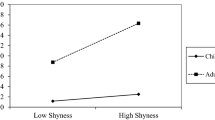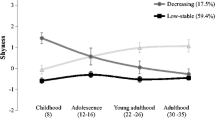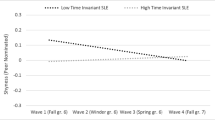Abstract
Many studies have documented the ways in which shyness can be a barrier to personal well-being and social adjustment throughout childhood and adolescence; however, less is known regarding shyness in emerging adulthood. Shyness as experienced during emerging adulthood may continue to be a risk factor for successful development. The purpose of this study was to compare shy emerging adults with their non-shy peers in (a) internalizing behaviors, (b) externalizing behaviors, and (c) close relationships. Participants included 813 undergraduate students (500 women, 313 men) from a number of locations across the United States. Results showed that relatively shy emerging adults, both men and women, had more internalizing problems (e.g., anxious, depressed, low self-perceptions in multiple domains), engaged in fewer externalizing behaviors (e.g., less frequent drinking), and experienced poorer relationship quality with parents, best friends, and romantic partners than did their non-shy peers.
Similar content being viewed by others
Notes
Given the reduction in variance of the shyness variable by splitting it into groups, analyses were also conducted using multivariate multiple regression with shyness as a continuous variable. The results using regression analyses were virtually identical to those using MANOVA.
References
Asendorpf, J. B. (1989). Shyness as a final common pathway for two different kinds of inhibition. Journal of Personality and Social Psychology, 57, 542–549.
Asendorpf, J. B. (1991). Development of inhibited children’s coping with unfamiliarity. Child Development, 62, 1460–1474.
Asendorpf, J. B. (1993). Beyond temperament: A two-factor coping model of the development of inhibition during childhood. In K. H. Rubin & J. Asendorpf (Eds.), Social withdrawal, inhibition, and shyness in childhood (pp. 265–290). Hillsdale, NJ: Erlbaum.
Arnett, J. J. (1997). Learning to stand alone: The contemporary American transition to adulthood in cultural and historical context. Human Development, 41, 295–315.
Arnett, J. J. (2000). Emerging adulthood: A theory of development from the late teens through the twenties. American Psychologist, 55, 469–480.
Arnett, J. J. (2003). Conceptions of the transition to adulthood among emerging adults in American ethnic groups. In J. J. Arnett & N. L. Galambos (Eds.), New directions in child and adolescent development: Exploring cultural conceptions of the transition to adulthood, 100, 63–75.
Arnett, J. J. (2004). Emerging adulthood: The winding road from the late teens through the twenties. New York: Oxford University Press.
Bianchi, S. (1990, June). America’s children: Mixed prospects. Population Bulletin. Washington, DC: Population Reference Bureau.
Boivin, M., Hymel, S., & Bukowski, W. M. (1995). The roles of social withdrawal, peer rejection, and victimization by peers in predicting loneliness and depressed mood in childhood. Development and Psychopathology, 7, 765–785.
Bruch, M. A., Gorsky, J. M., Collins, T. M., & Berger, P. A. (1989). Shyness and sociability reexamined: A multicomponent analysis. Journal of Personality and Social Psychology, 57, 904–915.
Buchanan, C. M., Maccoby, E. E., & Dornbusch, S. M. (1991). Caught between parents: Adolescents’ experience in divorced homes. Child Development, 62, 1008–1029.
Burgess, K. B., Rubin, K. H., Cheah, C. S. L., & Nelson, L. J. (2001). Behavioral inhibition, social withdrawal, and parenting. In W. R. Crozier & L. E. Alden (Eds.), International handbook of social anxiety: Concepts, research, and interventions relating to the self and shyness (pp. 137–158). Sussex, UK: Wiley.
Buss, A. H. (1986). A theory of shyness. In W. H. Jones, J. M. Cheek, & S. R. Briggs (Eds.), Shyness: Perspectives on research and treatment (pp. 39–46). New York: Plenum.
Carbery, J., & Buhrmester, D. (1998). Friendship and need fulfillment during three phases of young adulthood. Journal of Social and Personal Relationships, 15, 393–409.
Carroll, J. S., Willoughby, B., Badger, S., Nelson, L. J., Barry, C. M., & Madsen, S. D. (2007). So close, yet so far away: The impact of varying marital horizons on emerging adulthood. Journal of Adolescent Research, 22, 219–247.
Caspi, A. (2000). The child is father of the man: Personality continuities from childhood to adulthood. Journal of Personality and Social Psychology, 78, 158–172.
Caspi, A., Elder, G. H., & Bem, D. J. (1988). Moving away from the world: Life-course patterns of shy children. Developmental Psychology, 24, 824–831.
Caspi, A., & Silva, P. A. (1995). Temperamental qualities at age three predict personality traits in young adulthood: Longitudinal evidence from a birth cohort. Child Development, 66, 486–498.
Cheek, J. M., & Krasnoperova, E. N. (1999). Varieties of shyness in adolescence, adulthood. In L. A. Schmidt & J. Schulkin (Eds.), Extreme fear, shyness, and social phobia: Origins, biological mechanisms, and clinical outcomes (pp. 224–250). New York: Oxford University Press.
Coplan, R. J., Findlay, L. C., & Nelson, L. J. (2004). Characteristics of preschoolers with lower perceived competence. Journal of Abnormal Child Psychology, 32, 399–408.
Coplan, R. J., Rubin, K. H., Fox, N. A., Calkins, S. D., & Stewart, S. L. (1994). Being alone, playing alone, and acting alone: Distinguishing among reticence and passive and active solitude in young children. Child Development, 65, 129–137.
Crozier, W. R. (2002). Shyness. The Psychologist, 15, 460–463.
Gest, S. D. (1997). Behavioral inhibition: Stability and associations with adaptation from childhood to early adulthood. Journal of Personality and Social Psychology, 72, 467–475.
Hart, C. H., Yang, C., Nelson, L. J., Robinson, C. C., Olsen, J. A., Nelson, D. A., Porter, C. L., Jin, S., Olsen, S. F., & Wu, P. (2000). Peer acceptance in early childhood and subtypes of socially withdrawn behavior in China, Russia and the United States. International Journal of Behavioral Development, 24, 73–81.
Hymel, S., Bowker, A., & Woody, E. (1993). Aggressive versus withdrawn unpopular children: Variations in peer and self perceptions in multiple domains. Child Development, 64, 879–896.
John, O. P., Caspi, A., Robins, R. W., Moffitt, T. E., & Stouthamer-Loeber, M. (1994). The “Little Five”: Exploring the nomological network of the Five-Factor model of personality in adolescent boys. Child Development, 65, 160–178.
Kagan, J. (1999). The concept of behavioral inhibition. In L. A. Schmidt & J. Schulkin (Eds.), Extreme fear, shyness, and social phobia: Origins, biological mechanisms, and clinical outcomes (pp. 3–13). New York: Oxford University Press.
Kagan, J., & Moss, B. A. (1962). Birth to maturity. New York: Wiley.
Kagan, J., Reznick, J. S., & Snidman, N. (1988). Biological bases of childhood shyness. Science, 240, 167–171.
Kerr, M., Lambert, W. W., & Bem, D. J. (1996). Life course sequelae of childhood shyness in Sweden: Comparison with the United States. Developmental Psychology, 32, 1100–1105.
Markey, C. N., Markey, P. M., & Tinsley, B. J. (2003). Personality, puberty, and preadolescent girls’ risky behaviors: Examining the predictive value of the Five-Factor Model of personality. Journal of Research in Personality, 37, 405–419.
Melchior, L. A., & Cheek, J. M. (1990). Shyness and anxious self-preoccupation during a social interaction. Journal of Social Behavior and Personality, 5, 117–130.
Neeman, J., & Harter, S. (1986). Manual for the self-perception profile for college students. Unpublished manuscript, University of Denver: Denver, Colorado.
Nelson, L. J., & Barry, C. M. (2005). Distinguishing features of emerging adulthood: The role of self-classification as an adult. Journal of Adolescent Research, 20, 242–262.
Nelson, D. A., Nelson, L. J., Hart, C. H., Yang, C., & Jin, S. (2006a). Parenting and peer group behavior in cultural context. In X. Chen, D. French & B. Schneider (Eds.), Peer relations in cultural context (pp. 213–246). Cambridge, MA: University Press.
Nelson, L. J., Hart, C. H., Wu, B., Yang, C., Roper, S. O., & Jin, S. (2006b). Relations between Chinese mothers’ parenting practices and social withdrawal in early childhood. International Journal of Behavioral Development, 30, 261–271.
Nelson, L. J., Rubin, K. H., & Fox, N. A. (2005). Social withdrawal, observed peer acceptance, and the development of self-perceptions in children ages 4 to 7 years. Early Childhood Research Quarterly, 20, 185–200.
Putnam, S. P., Ellis, L. K., & Rothbart, M. K. (2001). The structure of temperament from infancy through adolescence. In A. Eliasz & A. Angleitner (Eds.), Advances/proceedings in research on temperament (pp. 165–182). Berlin: Pabst Scientist Publisher.
Renshaw, P. D., & Brown, P. J. (1993). Loneliness in middle childhood: Concurrent and longitudinal predictors. Child Development, 64, 1271–1284.
Rothbart, M. K., Ahadi, S. A., & Evans, D. E. (2000). Temperament and personality: Origins and outcomes. Journal of Personality and Social Psychology, 78, 122–135.
Rubin, K. H., Burgess, K. B., & Coplan, R. J. (2002a). Social withdrawal and shyness. In P. K. Smith & C. H. Hart (Eds.), Handbook of childhood social development (pp. 329–352). Oxford: Blackwell.
Rubin, K. H., Burgess, K. B., & Hastings, P. D. (2002b). Stability and social-behavioral consequences of toddlers’ inhibited temperament and parenting behaviors. Child Development, 73, 483–495.
Rubin, K. H, Burgess, K. B., Kennedy, A. E., & Stewart, S. L. (2003). Social withdrawal in childhood. In R. A. Barkley & E. J. Mash (Eds.), Child psychopathology (2nd ed. pp. 372–406). New York: Guilford Press.
Rubin, K. H., Chen, X., & Hymel, S. (1993). Socioemotional characteristics of withdrawn and aggressive children. Merrill-Palmer Quarterly, 39, 518–534.
Rubin, K. H., Chen, X., McDougall, P., Bowker, A., & McKinnon, J. (1995). The Waterloo longitudinal project: Predicting internalizing and externalizing problems in adolescence. Developmental and Psychopathology, 7, 751–764.
Rubin, K. H., Nelson, L. J., Hastings, P. D, & Asendorpf, J. B. (1999). The transaction between parents’ perceptions of their children’s shyness and their parenting styles. International Journal of Behavioral Development, 23, 937–958.
Sanson, A., Hemphill, S. A., & Smart, D. (2004). Connections between temperament and social development: A review. Social Development, 13, 142–170.
Schulenberg, J. E., & Zarrett, N. R. (2006). Mental health during emerging adulthood: Continuity and discontinuity in courses, causes, and function. In J. J. Arnett & J. L. Tanner (Eds.), Emerging adults in America: Coming of age in the 21st century (pp. 135–172). Washington, DC: American Psychological Association.
Smith, M. J., Abbey, A., & Scott, R. O. (1993). Reasons for drinking alcohol: Their relationship to psychosocial variables and alcohol consumptions. International Journal of Addictions, 28, 881–908.
Ward, C. C., & Tracey, T. J. G. (2004). Relation of shyness with aspects of online relationships involvement. Journal of Social and Personal Relationships, 21, 611–623.
Whitehead, B. D., & Popenoe, D. (2001). The state of our unions: The social health of marriage in America. Retrieved August, 2002, Available from: http://marriage.rutgers.edu
Whitehead, B. D., & Popenoe, D. (2002). The state of our unions: The social health of marriage in America. Retrieved August, 2002, Available from: http://marriage.rutgers.edu
Younger, A. J., Schneider, B. H., Wadeson, R., Guirguis, M., & Bergeron, N. (2000). A behavior-based peer-nomination measure of social withdrawal in children. Social Development, 9, 544–564.
Acknowledgments
The authors express appreciation to the instructors and students at all Project READY data collection sites for their assistance. We also are grateful for the grant support of the Family Studies Center at Brigham Young University, as well as the junior faculty sabbatical grant given to the fourth author by Loyola College in Maryland.
Author information
Authors and Affiliations
Corresponding author
Rights and permissions
About this article
Cite this article
Nelson, L.J., Padilla-Walker, L.M., Badger, S. et al. Associations Between Shyness and Internalizing Behaviors, Externalizing Behaviors, and Relationships during Emerging Adulthood. J Youth Adolescence 37, 605–615 (2008). https://doi.org/10.1007/s10964-007-9203-5
Received:
Accepted:
Published:
Issue Date:
DOI: https://doi.org/10.1007/s10964-007-9203-5




